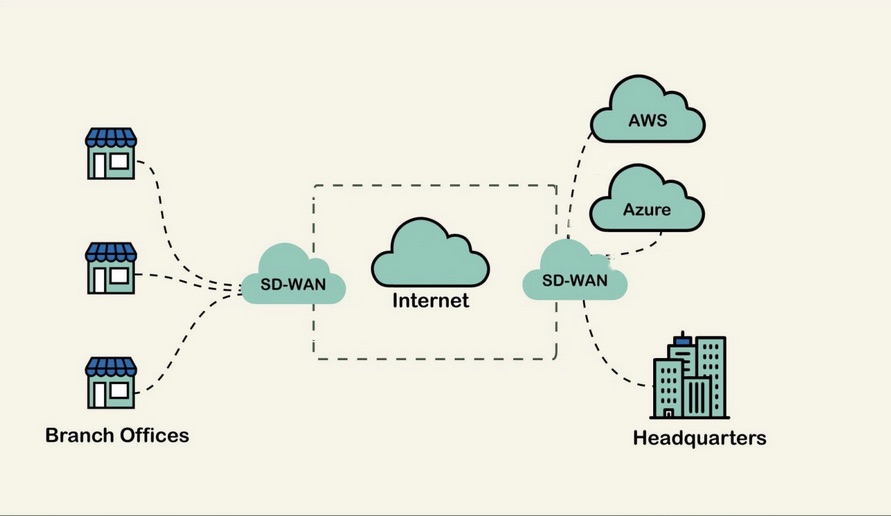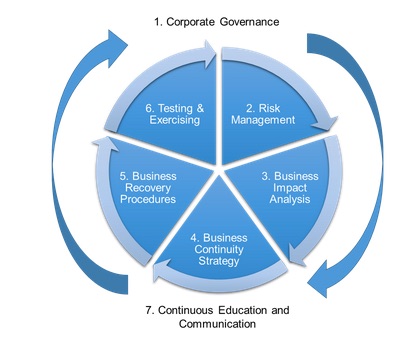Why Company Should Consider Deploying SD-WAN
Table of Contents
In a rapid growth of application in fulfilling the business needs. the requirement of bandwidth became higher and higher. Also, due to the increase in globalization for many businesses around the world. Connectivity became a must-have and no longer a nice to have services.
Since 2010, SD-WAN became a very widely spoken term mentioned. What is SD-WAN? SD-WAN – Software-Defined Wide Area Network
SD-WAN is a technology that was implemented on an enterprise WAN, to effectively communicate between various sites across the world.

Compared with the traditional WAN connectivity, such as MLPS (Multi-Protocol Label Switching) connectivity. SD-WAN connectivity provides a more cost-effective and investment productive returns, as compared to the MLPS, which cost easily 4 digits per month, in Singapore Context.
Benefit of SD-WAN
Lower Cost
Why SD-WAN is able to deliver a lower cost. One of the key reasons is, SD-WAN is software-driven rather than hardware. It operates as a configurable service over the physical Internet connection.
Traditional MPLS required an additional connection for the WAN. Also, the circuit cost for MPLS, in general, is higher as compared to the internet circuit. Since all company already has an Internet connection established. SD-WAN can run over the same internet connection, thru reduce the investment on two connectivity charges.
In the Singapore context, Telco in Singapore does provide private WAN Connection between various sites. SD-WAN will be a good approach to establish cost-saving the same time, free corporate from the “lock-down” contract by the telco.
Some companies do subscript a backup link for the purpose of BCM (Business Continuity Management). The company is paying, in addition, about 75% of the line cost. This investment is to “reserves” the connection, in case it is required. With SD-WAN, we can deploy a 4G, in today’s Mobile Network and 5G, which is the next generation Mobile Network as standby connectivity.
Higher Flexibility
Unlike MPLS, SD-WAN uses software definition. This allows the flexibility to configure how the routing can be determined.
In addition, as it runs over the existing Internet connection. The software defines feature allows the control of security, plus a single control console to monitor the uptime of the connectivity.
Business Continuity Management

SD-WAN, having dynamic in nature, businesses are in control of the traffic and how information is to flow in the network. This control can also define, the flow of traffic under certain conditions including a total outage situation.
Software-define, which means we can invoke the BCM plans which give priority to applications and/or user. Thus ensuring the business remains operational. Should the users are not able to work on-site, The connection via SD-WAN can be used with the selected applications. Depending on the organization IT policy and security.
Better Application Performance
Application is the key baseline of any business today. If the application is not functioning. Many if not all the business function will be severely affected.
If the performance of the application is slow. The productivity will drop and resulting in a drop in company profit. Today, many companies are running applications from the cloud. Connectivity and performance are the primary needs.
With globalization, the deployment of the application is commonly in the cloud instance. Each and every site office will be accessing it through their respective location. Should the stability of the connection is not dynamic. The impact on application performance is severe.
Vendor Neutral
With the deployment of SD-WAN. There is no “lock-down” to a single vendor the solution.
The hardware platform, can be of different vendors and switch to another if there is a better one in the market,
This option allows an organization to determine, which is a better and most cost-effective solution. In the computation of ROI (Return Of Investment).
Especially in a retail or distribution frontage operational environment such as Supermarket, Food Chain operator, etc.. where the connection is required. Using public connection operating in this environment can potentially post a risk on infrastructure security.
Centralised management
Regardless of how many site you have, to be established using the SD-WAN technology. All the SD-WAN management can be centralised. Having to be centralised, this made the configuration across various sites faster and more effective.
Being centralised, it also allows templates to be created for each site. This templates will share the same routing policies accordingly.
With these assignments of templates to multiple sites, policies can be defined and the network manager is able to apply changes to the various sites easier and a single click. The configuration for these can be determined almost close to real-time.
Visibility On The Network
Having to establish the connection via a single link out. You can decide, which of the connection have higher bandwidth and which has lower. It allows better control on the usage and higher bandwidth is being allocated to the more critical application
Time to Deployment
Since the deployment has been completed. Any additional required, being a Software-Defined solution. It will be just configuration on the existing template.
This made the requirement to market much faster. There is no requirement to wait for the lead time of any hardware.
Cloud Ready
Organization todays are increasingly adopting the use of cloud services. One of the feature of SD-WAN is, it allows direct access to the cloud at the remote branch. This will reduce the amount of routing of traffic between cloud and office through the data center.
Which means user accessing the cloud application can access directly, without the needs of going to your office or data center network. Thus reduce the overhead in the bandwidth in the office network. It also reduces the risk of security in the office environment.
Reduce Design Complexity
There is more and more organization moving into digital transformation. The implementation of a transformation solution can potentially add complexity to the network.
This results in, not only poor network performance but also additional resources to manage the on-site and remote site, to manage the infrastructure.
The use of SD-WAN overcome this. It off-loads those non-critical business applications and gives priority to those that are mission-critical.
SD-WAN is not perfect. Although there a long list of benefit in using SD-WAN, there are also the flip side on it.
Disadvantage of using SD-WAN
Adoption
Although SD-WAN been in the market for some time. It is still not very widely adopted in any organization.
Today’s organization is still very much rely on old technology, which mainly MPLS. For those organization that are more tech fronting, they will take the approach of a hybrid model, to ensure continuity is there, before the full cut-over
Ownership of design
SD-WAN, being a software define solution, is mostly a Self Service operation. That means the IT professional in the organization will require the skillset to build and maintain.
Of cause, this can be outsourced to 3rd parties vendors to do the job. But in the end, it is still the responsibility of internal IT forks to decide how and what the flow should be.
Should you decide to pass everything to an external vendor, the saving of the deployment might not able to cover the resources from the vendor in providing and maintaining it.
Performance
Although there are benefits, that you can allocate bandwidth by the respective application. There is still a possibility of jitter and loss of network packet during transmission.
Continue monitoring of the network, especially during the initial implementation of any application, is important. This is to ensure, the newly deployed solution does not affect the existing application flow.
Network Security
SD-WAN is still more at the network layout. There is no security feature that comes with SD-WAN.
Should this approach of deployment is adopted, the is a requirement to look into how security can be deployed to ensure minimum risk on network vulnerability
Approach to SD-WAN
Although there is a long list of benefits to moving into the SD-WAN solution. There are also some limitations or disadvantages of taking into consideration.
From the infrastructure point of view, the decision to deploy SD-WAN has to think through seriously. Identifying the benefit and finally, the approach of migrating to SD-WAN.
Should the migration of from current to Hybrid model, cut-over by site, or big band and migrate over. The decision on what is the bandwidth to support the SD-WAN after migration should also be taken into consideration
Lastly, there are many different types of products made available in the market, for the deployment of SD-WAN. Personally, I will suggest looking into the SD-WAN equipment that has embedded with the Firewall feature. This will be an add-on to the SD-WAN solution. to overcome the gap of security.


